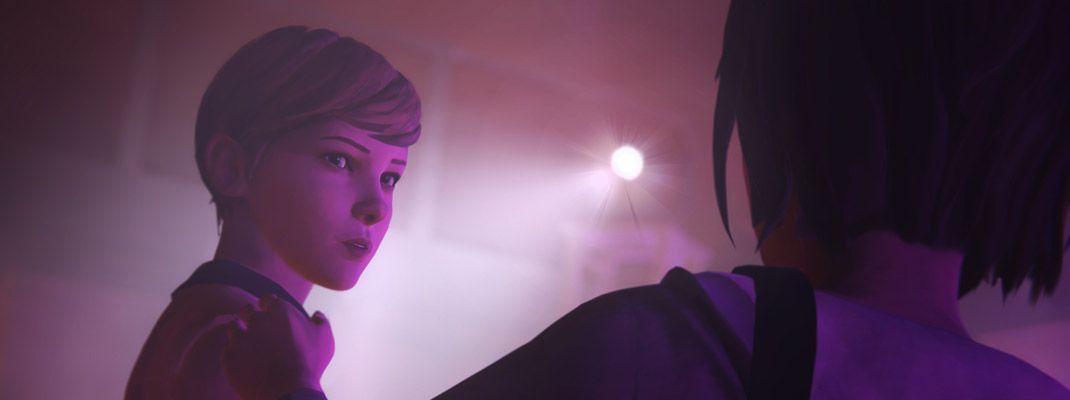The meticulous preparation, timing and execution necessary for effectively utilizing a cliffhanger ending can be considered as one of the most daunting feats to perfect in almost any type of medium. There have been few cases where it’s been pulled off flawlessly -- some might even claim that it’s never been attained -- but the last time I vividly witnessed an emotionally charged, well-crafted ending was in Dontnod Entertainment’s Episode 3: Chaos Theory. Dontnod elevated the episodic series’ expectations to an unprecedented level with the thrilling and stunning conclusion delivered in the previous episode, so it wasn’t much of a surprise that Episode 4: Dark Room, the penultimate chapter in Life Is Strange, would need its own ‘ace in the hole’ to raise the bar even further (that is, if it was even possible). As my four-hour-long playthrough of Episode 4: Dark Room finally came to a close, I couldn’t have expected more of an impeccable episode in terms of its storytelling, themes, voice acting and character development.
Creating the hard-hitting decisions that will alter the direction of the narrative is where Dontnod has continued to develop with the utmost precision, as the choices made in Episode 4: Dark Room replicate a similar short- or long-term impact that Episode 1: Chrysalis, Episode 2: Out of Time and Episode 3: Chaos Theory have already had on the overall story of Life Is Strange. In fact, it’s evident in the first hour of Episode 4: Dark Room that the game-changing decisions will be coming through thick and fast, with heroine Maxine Caulfield attempting to comprehend the full consequences of distorting time and creating an alternative timeline through the misuse of her power. Dontnod slowly but surely builds up to a beautiful and touching scene between Chloe and Max in the episode’s opening, with the French-based developer once again tugging on the emotional heartstrings of a player by allowing them to dictate the outcome of the most shocking segment in the title to date (choosing between life or death, basically). Frankly, it’s the type of real-life situation that nobody wants to be placed in, and it’s probably for that reason why it’s so poignant and effectual as choices presented in past episodes of Life Is Strange.
Since the release of Life Is Strange’s first episode in January 2015, Dontnod made its intentions clear as day that it would be tackling hot-button topics that are often scrutinized for how they are depicted in gaming, TV and films. With social themes like drugs, bullying and social media reoccurring throughout the entire series, Episode 4: Dark Room carries on this trend and begins to address other real-world difficulties that people might face, including disability and debt (it’s worth noting that I haven’t mentioned one crucial theme, which is linked with making a significant choice in the story, for the sake of keeping this a spoiler-free review). These themes intertwine with one another in Episode 4: Dark Room’s story and convey powerful messages, especially for how Dontnod is handling them in a mature and respectful manner -- something that other developers and publishers should be paying close attention to.
Despite the fact that there are still a few issues in regards to the quality of Life Is Strange’s writing -- a reoccurring problem since day one, unfortunately -- Dontnod has attempted to improve upon this aspect with the release of each new episode. Episode 4: Dark Room has several cases where the voice actors for Max and Chloe, Hannah Telle and Ashly Burch respectively, have had even better conversational exchanges due to how well the writing is beginning to flow. From the beautifully shot opening all the way up to the climactic finale of Episode 4: Dark Room, I found myself becoming even more attached to both Max and Chloe with each passing minute, with both Telle and Burch delivering yet another superlative performance.
Episode 4: Dark Room is where the plot has been at its strongest, as Dontnod begins to unravel the strange circumstances behind Rachel Amber’s disappearance and also the supernatural elements of the story, specifically the impending arrival of a tornado that Max has foreseen in her visions. The story, however, suffers from some minor pacing issues, but the way these two storylines are merged in a single episode had me totally engrossed in what was happening. Like Max and Chloe, I wanted answers behind Rachel’s disappearance, and the entire story arc has been so well established that I was more than satisfied once I discovered the truth. The Rachel story also allowed Dontnod to add a new dynamic to the gameplay experience, as Max must do a CSI-esque investigation by acquiring evidence from different people, like Nathan Prescott and David Madsen, and the player must sift through all of their sources and connect the ones that have any relevance to Rachel’s disappearance.
One of my favorite aspects about Life Is Strange, as a whole, is the freedom that Dontnod allows in interacting with the environment and characters. Episode 4: Dark Room brings back minor characters from past episodes and subtly touches upon some of the choices that had a butterfly effect, while also making it feel like these characters have both a purpose and relevance to the world that they reside in. Considering that an emphasis is placed on the fact that this is Max’s coming-of-age story, it would have been in bad taste if a majority of these characters had an insignificant role and were nothing more than throwaways once they’ve been used, but Dontnod really makes me connect and care for the different people in the universe. Episode 4: Dark Room does something that a lot of other episodic series have failed to do at such a late stage: it continues character development of the main and supporting cast. David Madsen (Chloe's stepfather) and Nathan Prescott are two examples of how some on-screen time can add substantial backstory or create a better understanding behind their motives.
Life Is Strange‘s exquisite art direction is seen in its full effect in Episode 4: Dark Room, with this being one of the first occasions where the visuals are significantly changed depending on the location that Max and Chloe travel to. The vibrant colors of Blackwell Academy reinforce the stunning visuals I’ve continued to praise and admire since Episode 1: Chrysalis, while we see the darker side of the aesthetics at the End of the World party, for example. I previously mentioned in my review of Episode 3: Chaos Theory that it had “an open-ended cliffhanger that is nothing short of the best jaw-dropping conclusion to any episodic title to date.” Well, Dontnod did it again by replicating an ending for Episode 4: Dark Room that left me rooted to my chair in disbelief. The shock value was something that I could hardly have imagined, but it does exactly what Episode 3 did by establishing an enticing plot point that the next episode can effortlessly build upon.
Closing Comments:
Life Is Strange producer Luc Baghadoust said at E3 last month that Episode 4: Dark Room would be “intense,” in which he added that the actors’ voice-over recording sessions brought tears to his eyes. I can relate to his comments, as Episode 4: Dark Room has unexpected twists and turns around every corner, with several gut-punching scenes that would sink the heart of any player. Episode 4: Dark Room shows how far Dontnod has continued to push the limits of Life Is Strange, with every choice made, regardless of how significant it might be, having a real meaning behind it. I made a bold claim after the third episode’s release that Life Is Strange has all the potential of being a strong candidate for GOTY. Episode 4: Dark Room went far enough to reaffirm that statement could easily become a reality. With Episode 4: Dark Room finishing on a brilliant cliffhanger, Dontnod will no doubt be firing on all cylinders as they head towards the finish line for Life Is Strange with some serious momentum behind them.
Life is Strange
Reviewed on PlayStation 4




